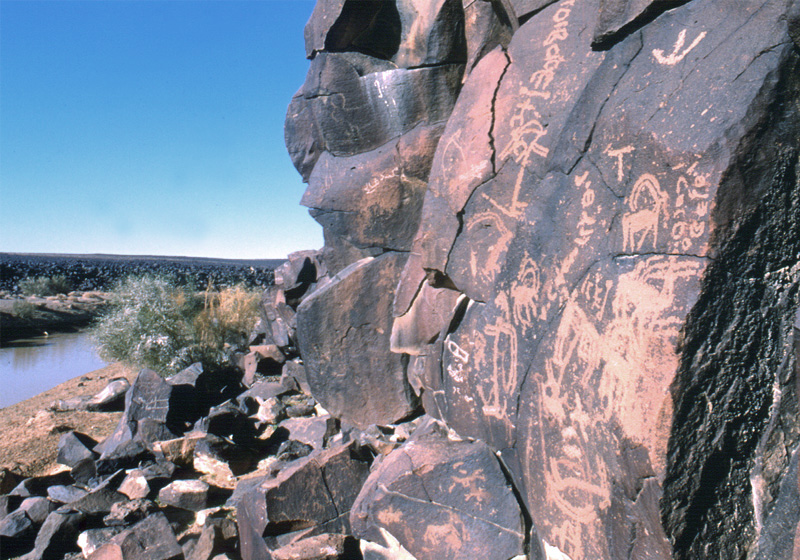Gallery in the Desert
The sense of arrival in Azraq is great. Vast horizons, light clean air, and distinct ethnic flavors all give a feeling of being in a place different from the rest of Jordan. Azraq and the desert beyond remain the kingdom's best destinations for unrestricted panorama, open horizons and a gratifying sense of freedom.
From Azraq, remote mountains appear as pyramids in hazy rust-red, floating on beige flats that turn into a silver mirage as they melt into the horizon. Most of these hills and mountains are to the north and east of Azraq, and all were created by volcanic activity millions of years ago. Tall Hassan is one of the smaller dormant volcanic vents of these hills and the only one easily recognizable to the south of the road. Beyond it, further to the southeast, hidden quietly away from people, is a charming valley called Wadi Hassan, where a remarkable collection of rock art can be seen. This place is a small gem, a forgotten splendor, and a secret, kept only for those who demand a private viewing of Jordan’s natural cultural heritage, exclusively reserved for their inspection.
Wadi Hassan has a basalt cliff that stands as a vertical wall about 5 meters high. Here, the volcanic lava stopped flowing and started cooling into hard stone. The rate of cooling affected the shape of these rocks; the slower the cooling, the more pillar-like they appear. Wadi Hassan has easily recognizable pillars with smooth surfaces weathered into a shiny, attractive, deep-red lustre, turning at times into hues of black iris.
On this cliff, the shepherd-artists left us a collection of drawings. Their artworks, often signed, are an impressive expression of their lives. Their style is basic and powerful, using mostly lines created by hammering the surface of the rock to create tiny fractures that scatter the sunlight. With time, these images and letters get darker, which makes some of the older inscriptions hardly decipherable from the background rock.

"Safaitic inscriptions" is a term used for such rock-art found in the deserts of northern Jordan, while the same type of language and art is called "Thamudic" in the south. The Safaitic language must have sounded like Arabic; it basically consists of condensed Arabic words with no vowels and often refers to names in the Arabic manner that include the father and often many of the grandfathers after the first name, and all are connected with “bin” (the son of). The compressing of words can be simulated as follows: Muhammad drew a camel: “Mhmd dru cml”. Unlike Arabic, English or other languages that follow a consistent direction (from right to left or from left to right, etc), Safaitic was written in all directions and sometimes in curves or spirals. It is confusing even to epigraphists who have to depend on certain letters to determine the direction of words.
These inscriptions date from the first century BC to the third century AD. They were made by Safaitic Bedouin tribes who lived a nomadic life on the lands which are now part of Saudi Arabia, Iraq, Jordan and Syria. Those shepherds, hunters, traders and warriors left no architecture, but their art depicted much of their names and the animal life around them, as a living record of desert animals that were once in abundance. Included were ostriches, ibex, oryx, not anymore found in this natural habitat.
Wadi Hassan is an open-air gallery where artworks of Safaitic Bedouins are on display permanently, tattooing this land to record a small hint of their vanished lives. This is their modest quest for eternity.
Azraq is an hour's drive from Amman. After Azraq Al Shamali, drive for another 8 km on the road to Iraq, and about one kilometer past the only black hill with a quarry –a small volcano called Tall Hassan- exit to the right, southward, on an unpaved dirt road used by trucks transporting limestone. After about half a kilometer turn right into a less used, less dusty and more bumpy track heading south. You are now driving on black basalt and you should be soon arriving at a valley with desert shrubs where Wadi Hassan meets Wadi Usaykhim. Cross the wadi and turn westward at its southern bank. You should now arrive at a dead-end after less than 100m. This is the beginning of the cliff of Wadi Hassan. A reliable 4x4 is needed. Winter season is most suitable for the trip, provided you take care not to get stuck in wadi floods.